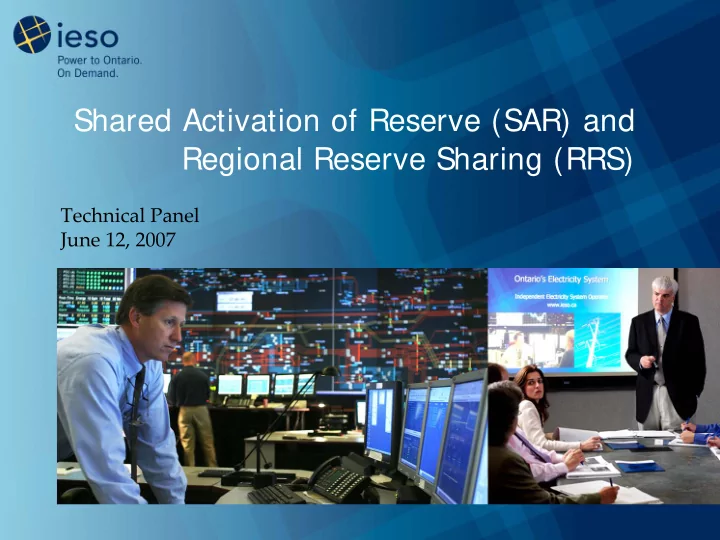

Shared Activation of Reserve (SAR) and Regional Reserve Sharing (RRS) Technical Panel June 12, 2007
Agenda • Shared Activation of Reserve (SAR) – Purpose – Activation details – Summary statistics • Regional Reserve Sharing (RRS) – Activation details – Process timelines – 2006 Experience • Pre ‐ and post ‐ contingency OR requirements 2
Purpose of SAR • To more quickly relieve stress on the interconnected transmission system following a contingency event • To effect an improvement in reliability achieved by the faster recovery • To assist in achieving compliance with the NERC Disturbance Control Standard Source: NPCC Document C ‐ 12 Procedures for Shared Activation of Ten Minute Reserve 3
Activation of SAR • Available for contingencies ≥ 500 MW • Area requiring assistance may request SAR for up to 50% of the total contingency loss • SAR request allocated proportionately amongst assisting areas, provided no transmission constraints – Allocations determined by NYISO • Assistance from SAR can be maintained for up to 30 minutes • Activation of SAR causes inadvertent interchange 4
Example – SAR Activation At T=30: MW • Area A activates 250 MW with 10-min ramp SAR • Areas B,C,D ramp out 250 MW over 10-min 500 400 250 MW picked up by Areas 500 MW 300 B, C, D generation loss in Area A 200 250 MW picked up by Area A 100 Time (minutes) 5 T=0 10 20 30 40 50 60 70 80 90 100
SAR Statistics: January 1, 2005 – December 31, 2006 SAR Events IESO ISO ‐ NE NBSO NYISO PJM Number of Requests for SAR 15 17 1 12 4 Average duration (minutes) 19 9 9 13 11 Average MW 420 318 160 418 493 Maximum MW 470 582 160 525 563 Number of SAR events lasting 4 0 1 0 0 the full 30 minutes Number of times SAR energy converted to RRS energy after 3 0 0 0 0 30 minutes 6
Activation of RRS • RRS energy only delivered after SAR has been utilized • After 30 minutes, 100 MW of SAR is converted to RRS energy which can be maintained for up to 60 minutes following the termination of SAR • RRS energy is only available as discrete 100 MW block, partial activation is not permitted • RRS activation creates inadvertent interchange 7
Example – SAR with RRS MW SAR RRS 500 400 250 MW picked up by Areas 500 MW 300 B, C, D generation loss in Area A 200 250 MW picked up by Area A 100 Time (minutes) 8 T=0 10 20 30 40 50 60 70 80 90 100
RRS – Process Timelines • Availability and deliverability of RRS energy is determined weeks in advance of real ‐ time – OR requirement is reduced by 100 MW, if RRS energy is available and deliverable • If circumstances change and RRS energy is no longer available due to capacity or tx constraints, 100 MW added back to OR req’t – Issue SSR with new OR requirement • RRS reduction is applied uniformly in both the unconstrained and constrained schedules 9
Experience with RRS January 4 – December 31, 2006 • NPCC Balancing Areas have not experienced any negative reliability impacts resulting from RRS • Three requests for delivery of RRS energy – All three requests by IESO – 100 MW of SAR energy converted to RRS Date Contingency Event Duration of RRS SPS rejected 700 MW of generation due to loss of May 30 47 minutes 500 kV transmission line in northeastern Ontario Nov 23 Nuclear unit turbine trip: 800 MW generation loss 60 minutes Dec 19 Nuclear unit turbine trip: 940 MW generation loss 38 minutes 10
OR Requirements Pre ‐ contingency • OR requirements not affected by SAR • RRS allows participating areas to reduce 10 ‐ min OR requirement by 100 MW, subject to energy being available in the event of a contingency – Existing market rules allow the reduction in non ‐ sync req’t only – MR ‐ 00332 proposes to allow reduction in either sync or non ‐ sync Post ‐ contingency • Following a contingency requiring the activation of OR, total 10 ‐ min OR requirement reduced by the full amount of the contingency 11
Recommend
More recommend